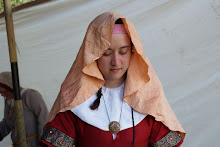Woad was one of western Europe's most important dyestuffs, which makes it no surprise that the woad industry was a powerful one. So when dyes like indigo (which produces more dye than Woad) and Logwood (which looks like woad at first, but fades quickly) were introduced in the late middle ages, there was some backlash. Pretty soon, laws began to be passed prohibiting them. Indigo was made illegal in what is now Germany in 1577 (and repeated in 1594 and 1603), saying it was the "devil's dye", and Nürnberg dyers had to take an oath promising not to use the dye every year.
The deceitful use of Logwood (selling cheap knock-offs is nothing new!) was made officially illegal in England by Queen Elizabeth I. Here is part of the text:
“Act of Queen Elizabeth I prohibiting the use of Logwood 1567
Anno vicesimo tertio Reginae Elizabethae
Cap. IX Logwood and Blockwood shall not be used in the dying of cloth, etc.
Whereas of late years there hath been brought into this Realm of England, from beyond the seas, a certain kind of Ware or Stuffe called Logwood, alias Blockwood, wherewith divers Dyers, Clothiers, Hatmakers and others have and do die daily, divers broad Clothes kersies, Woolls, Pennestones, Bayes, Cottons, Hose, Yarn, Hats, Caps, Flannels, Docadoes, Rashes, tuft Dockadoes, and other things, forasmuch as the colours made with the said stuff called Logwood is false and deceitful, and the Clothes and other things wherewith dyed, are not only sold and uttered, to the great deceit of the Queen’s loving subjects within this her Realm of England, but also beyond the Seas, to the great discredit and slander, as well of the Merchants, as of the Dyers of this Realm.
For reformation whereof, be it ordained, enacted and established, by the Queen our Sovereign Lady, and by the assent of the Lords Spiritual and Temporal, and by the authority of the same, that all such Logwood, alias Blockwood, in whose hands soever the same shall be found, after the Feast of St. Michael the Archangel next ensuing, shall be forfeited, and openly burnt by authority of a Mayor or other head officer of the City or Town Corporate, or of two Justices of the Peace of the County where it shall be found, and that from and after twenty days after the end of this session of Parliament, no person of what degree soever be he, shall dye or cause to be dyed any Cloth, Wooll, or any of the Premisses above mentioned, or anything whatsoever, with any of the said Ware or Stuff called Logwood, alias Blockwood, upon pain that the Dyer of every such thing so dyed, the one moity to the use of the Queen’s Majesty, her Heirs or Successors, and the other moiety to him that shall sue for the same, by action of debt, bill, plaint, or information, in any Court of Record, in which suit, no essoyne, protection, wager of Law, no writ of privilege for the defendant , shall be admitted or allowed; and the party offending, being thereof convicted, to remain in prison without bail or mainprize, till he have satisfied the same value. […]"
Source: Edmonds, John. “Historic Dyes Series No. 3: Medieval Textile Dyeing”. John Edmonds, 2003. Pp. 79-80.
Other sources:
http://en.wikipedia.org/wiki/Isatis_tinctoria#cite_note-2
http://web.mit.edu/21h.416/www/industrialtechnology/dyes.html
Subscribe to:
Post Comments (Atom)

It was really great. the salt bath also did bring the colors out better like you said it would
ReplyDeleteGreetings~
ReplyDeleteI have recently started a blog devoted to things medieval and, on occasion, I will be posing questions to others interested in the middle ages, the answers to be posted on my blog. I would be very interested in your answer to the following question:
What period or person from the middle ages most interests you and why?
Your answer can be as long or short as you wish and will be published in full on my blog. If you would like to participate, you may leave your response in the comments portion of my blog or email your response to kaya.alder at gmail.com. Please be sure to let me know how you wish your name to be shown in the post and any email address or website that you would like to have linked.
Thank you in advance,
Kaya
My Medieval: http://mymedieval.blogspot.com/
Hi Anya, I'm currently working with Mike Edmonds (John's son) to get all John Edmonds' books available online, and making an effort to collect all his work as a useful resource for people interested in historic dyes. Would it be possible for you to put a link to our site to go along with this article?
ReplyDeleteHe also published 5 other books on historical dyeing (complete with the traditional recipes) if you're interested.
Thanks in advance,
Sam
Sam, can you give me the web address?
ReplyDeleteHey Anya. Sorry for the delay in getting back to you, I've been very busy lately with very borng things - however, I see you managed to find us anyway!! I'm sure Mike will be able to sort the book out for you. As you now most likely know, our address is www.imperial-purple.com
ReplyDeleteThanks, Sam